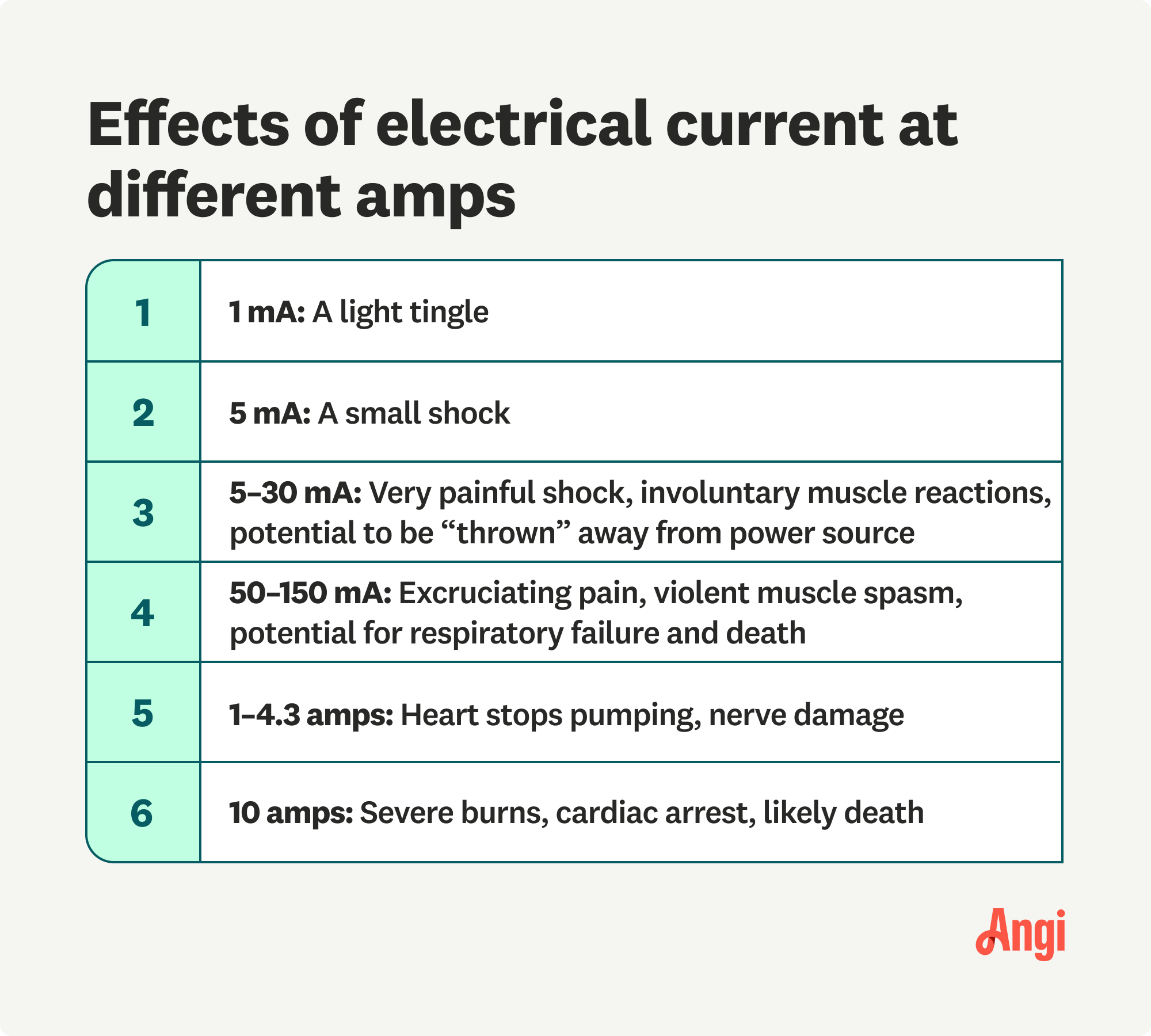Amps vs. Volts: What’s the Difference?
Understanding home electricity, measure by measure


Amps measure electric current.
Volts measure the pressure that’s moving electricity through a circuit.
Amps and volts can both be deadly if you don’t follow the right safety protocols.
The wonders of electricity are so deeply embedded in our lives that, from a young age, we learn specialized terms from physics without understanding what they mean outside of the context of buying different types of light bulbs or choosing the right outlet. Once you start doing DIY home projects, however, understanding the ins and outs of your power supply can be the difference between a job done well and a severe injury. So what are these units anyway, and what exactly is the difference between amps versus volts?
What Are Amps?

Amperes, or amps, were named after French scientist André-Marie Ampère, often called “the father of electromagnetism.” These are the standard unit of measure for electrical current, indicating the volume of electrons contained in a flow.
Think of the circuits in your home like pipes. Increasing the amperage is like turning the faucet handle and increasing the amount of water trickling through the pipes; more amps indicates a heavier flow of current to all the outlets downstream. If the amperage is too low, your devices won’t receive the electricity they need to function effectively and safely.
When you open the breaker box in your home, you’ll see circuit breakers of different sizes that are rated for 15 or 20 amps. These circuits can safely carry about 80% of the indicated ampacity (the maximum electrical current), or about 12 and 16 amps, respectively. Most of the circuits in your home are rated for 15 amps, which is the typical volume needed for most lighting fixtures and receptacle outlets. Usually, 20-amp circuits are dedicated to heavier-duty areas with lots of big appliances, like the kitchen and laundry area.
What Are Volts?

Volts indicate the amount of force pushing electrons through a circuit. The measure comes from the “electric potential difference” between terminals. This is essentially just the pressure required to carry a charge from point A to point B.
In the United States, service panels in most homes receive electricity from the grid in two different voltages: 120 and 240 volts. Small devices in your home, like light bulbs, computer chargers, and televisions, are powered at 120 volts. Bigger, energy-hungry appliances, like garbage disposals, clothes dryers, and air conditioners, must receive electricity at 240 volts to work properly.
If amps are compared to the amount of water flowing through your pipes, volts are like the water pressure. Even if the amperage meets your needs, your devices won’t get what they need if the flow is too weak.
Important Safety Protocols

Amps and voltage measure distinct things, and understanding both is important to keep yourself safe when DIYing any home electrical project. Even if you have experience, it’s always good to re-familiarize yourself with the basics of electrical safety. Working with electricity can be extremely dangerous, so if you don’t understand what you’re doing or want to minimize risk, you should always hire a local electrician instead of going it alone.
If you’re working on electrical tasks at home, always take a few essential precautions to decrease the risks that come with electrical work. First, wear rubber electrical gloves and rubber-soled shoes. These will prevent current from flowing through your body. Next, don’t work on anything electrical without first turning off the power at the breaker box. If there’s no current running to a device, you won’t fall victim to a dangerous shock. You can use a multimeter to double-check that you’re in the clear.
If you don’t remember anything else about electrical safety, remember this: Never work on a wire or circuit that’s live, aka one that has power running to it. Doing so is a recipe for electrocution.
Amperage is the most important measure to consider when evaluating the safety of an electrical project. If your body comes into contact with a small enough number of amps, you’ll feel nothing more than a slight shock. If the amperage is high enough, however, it can be instantly fatal, according to the Occupational Safety and Health Administration.
The effect of electrical current on the human body is usually discussed in terms of milliamperes (mA), which are 1/1,000th of an amp. It only takes 50 to 150 mA for you to potentially experience intense pain or even respiratory failure.

Being exposed to a high dose of current will wreak havoc on your body, no matter how slowly it comes. Voltage, on the other hand, is less likely to cause severe injury at levels as low as amps. Don’t make the mistake of thinking that volts are less dangerous, however. There have been reported deaths following exposure to as little as 42 volts.
What About Ohms and Watts?
There are two other terms of electrical measurement you may frequently encounter in the home: ohms and watts. Here’s what they mean for you and any projects you might embark on.
Ohms
Ohms measure resistance in the flow of electricity. Electricity travels through circuits on wires made of materials that conduct electricity with more or less friction. More friction means more resistance, which is also affected by other factors, like distance. Understanding the total amount of this resistance, in ohms, allows us to understand how much amperage and voltage will be needed to overcome it.
Along with voltage and current, this measure forms an empirical equation called Ohm’s law. It states: V = IR (voltage = current X resistance).
Watts
Watts measure the rate of power flow, or the power requirements of a particular device. The number captures electrical output over time given a particular resistance. In other words, it tells us how much electricity a device must consume to perform its job.
To calculate wattage, you can multiply volts by amps. Doing so can be really helpful in figuring out how much you’re paying for common household appliances, like your refrigerator, microwave, or ceiling fans, per hour, day, month, or even year.





- Home Generator Repair
- Lamp Repair
- Electric Repair
- Generator Installation
- TV Antenna Services
- Emergency Electricians
- Commercial Electricians
- Attic Fan Installation
- Attic Fan Repair
- Exhaust Fan Installation
- Electric Inspectors
- Subcontractors
- Electrical Construction
- EV Charger Installer
- Chandelier Installation
- Doorbell Installation
- Bathroom Fan Installation
- Ring Installers
- Electrical Panel Upgrade










